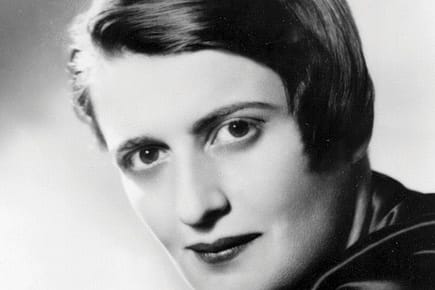Reason is All

A new biography of Ayn Rand takes us closer to one of the more complex literary personalities of the last century.
It is impossible to have not known or read Ayn Rand. For most readers, The Fountainhead and Atlas Shrugged were an introduction into the muscular world of Rand and her approach to individualism against collectivism. The appeal of Howard Roark, the young architect hero of The Fountainhead (published in 1943), who chased an individualistic approach, resisting the traditional, was enormous on her readers. Atlas Shrugged (1957), led by the hero John Galt, again spoke of a world where the government takes over collective control and the individual is expected to toe in, giving up on his mind and desires.
Rand's influence on America had been a powerful one as a polemicist on objectivism, and her philosophy of staunch individualism, reason, capitalism or market economy found many supporters, especially among right-wingers. Rand's compelling and persuasive philosophy about the pursuit of money and her career as a Hollywood screenwriter added to make her one of the most interesting personalities of our times.
At 19, Galt and Roark's petitions as young rebels seeking subjective gratification against a monochromatic social or governmental order held great appeal for her supporters. Both in her times and later, Rand's theories were challenged for advocacy of vulgar, selfish satisfaction and egoism. Whatever the position, Rand's influence remains powerful and her books continue to sell in thousands.
2026 New Year Issue
Essays by Shashi Tharoor, Sumana Roy, Ram Madhav, Swapan Dasgupta, Carlo Pizzati, Manjari Chaturvedi, TCA Raghavan, Vinita Dawra Nangia, Rami Niranjan Desai, Shylashri Shankar, Roderick Matthews, Suvir Saran
Revisiting Rand has never been as interesting as reading Heller's striking biography. It takes us closer to the creature that Rand was, a compelling entity whose advocacy of rebellion and individualism held a mesmeric quality over those around her, even detractors who rejected her idea of wealth. Heller includes interesting details of how Rand would wear dollar pins on her dress to advocate her support for capitalism, though she did not attach much importance to wealth when she gave up her royalties. Heller points out that for Rand, the wealth of ideas amounted to the intellectual capital she so cherished in her own life. Alan Greenspan might find her ideas appealing, but at heart Rand's philosophy owed more to Nietzsche, hints Heller.
Heller's tome talks about Rand, born Alissa Rosenbaum to Russian-Jewish parents who immigrated to America, and made New York her home to pursue a career in writing. The book is divided in a chronological order following her life and also some of the life of her followers after her passing. Heller finds that Rand's social criticisms of an industrial America were based on her grounding in 20th century Russian history. Heller explains at the outset that she is not an advocate of Rand's philosophy, but admires her facets. 'Whatever one thinks of her positive program of rational selfishness, egoism, and unregulated capitalism, her ability to spot and skewer cowardice, injustice and hypocrisy is at least as keen and passionate as that of her ideological opposite Charles Dickens.'
Heller's tome is filled with details about Rand's rise and growth in New York; interesting information about the many rejection slips her books faced; the background to her many fierce and forceful analogies, essays and speeches; her difficult relationships and her troubled marriage with Frank O'Conner, who bore the brunt of Rand's compelling personality and her distractions with her group of followers and younger men. These throw clarity into her complex personality.
For students of Rand and her worldview, and also others, the book is a must-read for a better understanding of one of the fiercely brilliant and distractingly original philosophers of the last century.
